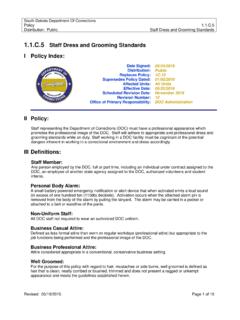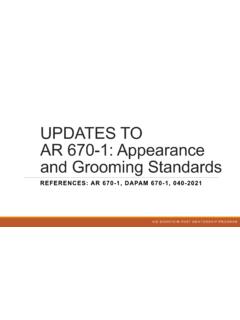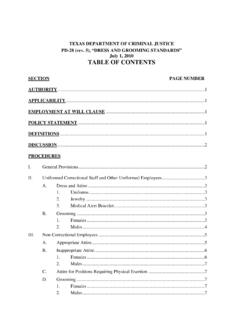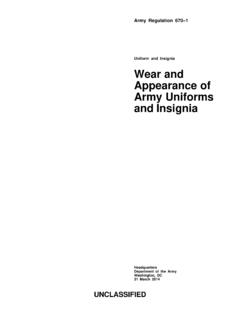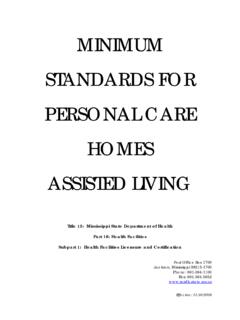Transcription of Air Force Dress and Appearance Standards - Det 040
1 Air Force Dress and Appearance Standards Lesson Preparation: ROTC: Read this complete lesson reader. OTS: Read part I of this lesson reader when directed; read part II of this lesson reader when directed. Cognitive Lesson Objective: Apply Air Force Dress and Appearance Standards . Cognitive Samples of Behavior: Define male and female hair Standards . Identify violations of AFI 36-2903, Dress and Personal Appearance of Air Force Personnel. Identify appropriate and inappropriate wear of eyeglasses, sunglasses, jewelry, and cosmetics. Identify proper wear of the Air Force Service Dress and other Service Uniform combinations. List occasions when wear of the Air Force uniform is prohibited. Affective Lesson Objective: Respond consistently to Air Force Dress and Appearance Standards . Affective Sample of Behavior: Conform to AFI 36-2903, Dress and Personal Appearance of the Air Force Personnel.
2 Air Force Dress and Appearance Standards 27. PART I. A. s an officer, you must display the qualities of a leader and apply the techniques of leadership. You'll set the example, so make it a good one! The manner in which you follow Dress and grooming Standards reflects pride in yourself, your profession, your unit, and the Air Force . You should always strive to exceed the minimum Standards in all you do, especially in Dress and grooming lead by example! The Air Force Dress and grooming Standards are a mixture of tradition and practicality. The uniform draws attention to the individual. The image you present will leave a lasting impression about you and the entire Air Force on everyone you meet. Any large business or organization that wants to be recognized as professional sets certain Standards of Dress and grooming for its personnel. The Air Force is no different.
3 The American public draws certain conclusions about military effectiveness based on the image that Air Force members present. It's been said that a military officer can be picked out of a crowd just by the image he or she presents. Certainly, one's weight control, military bearing, and confidence are part of this image. The image of a disciplined service member who can be relied on to do the job excludes the extreme, the unusual, and the faddish. Personal cleanliness, disciplined behavior, and pride in the uniform will directly affect morale in the everyday work environment. It's up to us to maintain ourselves as the professionals we are. More importantly, however, each of us represents the Air Force and the United States in general. Discredit on one brings discredit on all. Uniforms must be clean, neat, and correct in design and specifications, fitted properly, pressed, and in good condition ( , not frayed, worn out, faded, torn, patched, etc.)
4 All closures are to be kept zipped, snapped, or buttoned. Shoes requiring shining must be shined and in good repair. All service uniforms are authorized for year-round wear, unless the installation commander prescribes otherwise. As we explain the various uniform combinations, we'll concentrate on the officer's uniform. For information on proper wear of uniforms by enlisted Airmen, consult AFI 36-2903, Dress and Personal Appearance of the Air Force Personnel. BASIC PHILOSOPHY AND ENFORCEABILITY. T. he Air Force philosophy is that the uniform will be plain, distinctive, and standardized. This standardization includes a minimum number of authorized badges, insignia, and devices. Individual pride in one's personal Appearance and in wearing the uniform greatly enhances the esprit de corps essential to an effective military Force . Therefore, it's most important for all members to maintain a high standard of Dress and personal Appearance .
5 The four elements of this standard are neatness, cleanliness, safety, and military image. The first 28 three are absolute, objective criteria needed for the efficiency and well-being of the Air Force . The fourth military image is subjective, but necessary. Appearance in-uniform is an important part of military image. Judgment on what is the proper image differs in and out of the military. The American public and its elected representatives draw certain conclusions about our military effectiveness based on the image that Air Force members present. The image must instill public confidence and leave no doubt that service members live by a common standard and respond to military order and discipline. Each member has the responsibility to maintain an acceptable military image as well as the right, within limits, to express individuality through his or her Appearance . Members will wear only the uniform items prescribed by AFI 36-2903, Dress and Personal Appearance of the Air Force Personnel.
6 Personnel who violate the specific prohibitions and requirements of that regulation may be subject to appropriate administrative action or prosecuted under the Uniform Code of Military Justice (UCMJ). WEAR OF THE AIR Force UNIFORM. E. xcept when authorized to wear civilian clothes according to AFI 36-2903, Dress and Personal Appearance of the Air Force Personnel, Airmen will wear the appropriate Air Force uniform while performing their military duties. Personnel assigned to non-Air Force military installations will comply with the order of Dress that most nearly conforms to the order of Dress for the particular host service, for example, service uniform, combat uniform, and so forth. When the host service order of Dress is a combat uniform, Airmen will wear the Airman Battle Uniform (ABU). When authorized, members may also wear distinctive berets. Airmen attending a special event, either social or official, must wear the service Dress uniform unless the host or hostess requests civilian Dress or the commander specifies otherwise.
7 Airmen wear the service Dress uniform when the Air Force would benefit by having its representatives appear in that uniform. This rule applies to all social events not of a purely personal nature. A member who receives a written invitation that doesn't specify the Dress required should ask the social secretary or the secretary of the host organization for recommendations as to the expected Dress . When several Air Force activities are in the same locality, the senior commander will determine the proper Dress uniforms for specific seasons. Optional uniform items may be worn when a required item isn't prescribed. Commanders won't direct the wear of optional items unless these items are provided at no cost to Airmen. Commanders won't prohibit the wear of optional items. Members may alter uniform clothing to improve fit. However, these alterations must not change the intended Appearance or required function of the uniform as designed.
8 Air Force Dress and Appearance Standards 29. Terms Explained As used here, these terms mean the following: Right or Left. The wearer's right or left. Installation Commander. The person who is responsible for and controls the personnel, facilities, equipment, and real estate constituting an Air Force base, station, operating location, etc. On-Duty. The hours a person is actually at work, as required by assignment. Mandatory Uniform. A complete uniform combination of selected items from Airmen's mandatory clothing. Mandatory Clothing Items. Uniform clothing items each Airman must always have, according to AFI 36-2903, Dress and Personal Appearance of the Air Force Personnel. Optional Clothing Items. A uniform clothing item, other than a mandatory clothing item, approved for wear by all Air Force personnel. Accoutrements. Medals, ribbons, insignia, badges, emblems, tags, scarves, gloves, etc.
9 , authorized for wear on or with any uniform. Service Uniforms. All authorized blue uniform combinations. Basic Policy As an Airman, you're always in the public eye. The image you present reflects on us all. Therefore, it's extremely important you make a positive impression at all times. Personal Hygiene. This is at an individual's discretion. All Airmen should bathe and use toiletries as necessary to prevent any offensive odors. Personal grooming . Airmen must present a professional image at all times. Members should also appear neat and well groomed. Additionally, as stated before, avoid extreme and faddish styles. 30 PERSONAL grooming Standards . Hair Styles O. verall, hair should be clean, well-groomed, and neat. Avoid using an excessive amount of grooming aids (thus, it's not permissible to grow your hair long and slick it back while in uniform). You may dye your hair if you wish, but it must look natural.
10 Hair must not touch the eyebrows when groomed and may not protrude below the front band of properly worn headgear for males. For females, hair may be visible when headgear is properly worn. Males. Men's hairstyles must have a tapered Appearance on both sides and back, both with and without headgear. A tapered Appearance outlines the individual's hair to conform to the shape of the head, curving inward to the termination point. The bulk or thickness of hair must not exceed 11/4 inches, regardless of length. The bulk may not exceed 1/4 inch at the termination point. The hair must not touch the ears and only the closely cut or shaved hair on the back of the neck may touch the collar. A block cut is permissible as long as a Air Force Dress and Appearance Standards 31. tapered Appearance is maintained. Hair must not be worn in an extreme or faddish style, or in such a way that it exceeds length or bulk Standards , or violates safety requirements.
